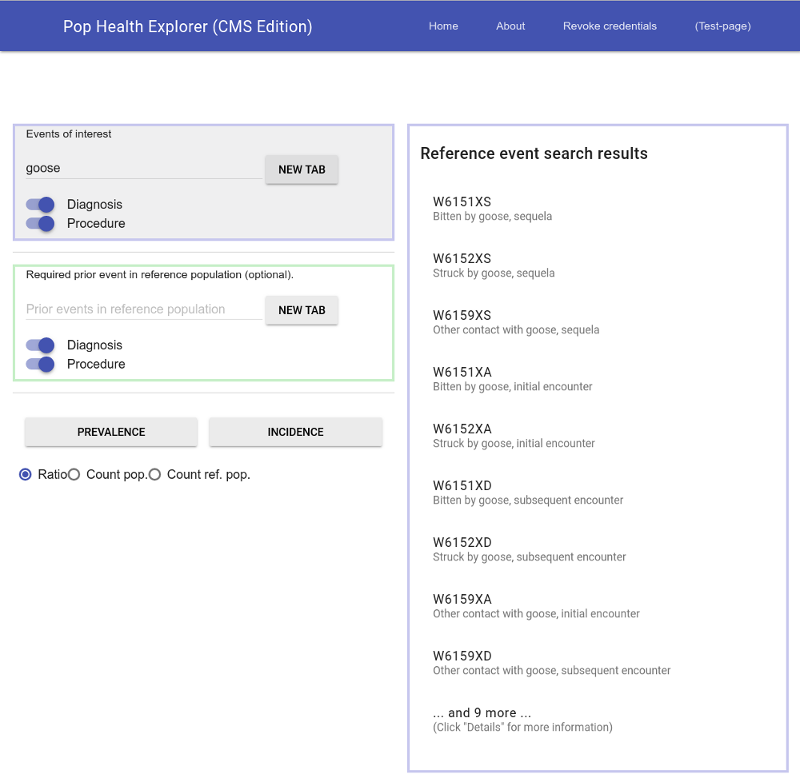- Data Description of the dataset.
- Events Events are recorded encounters between patients and the healthcare system.
- Prevalence and incidence Percentage of patients with events of interest.
- Populations of interest The reference population can also be specified through events of interest.
This is a proof-of-concept app using CMS data. This page is designed for users of the app, for information about the code, check the g3doc.
Issues and feature requests can currently be reported in buganizer.
Data
This tool is building dynamic summary statistics / aggregates from the restricted CMS dataset. The dataset is a random sample of the US population under Medicare and Medicaid, and this tool is only considering the fee-for-service (FFS) population as encounters with the healtcare systems are more systematically recorded for that population. For readers familiar with the CMS dataset, we are considering patient under A, B, and C (see below).
| Code | Meaning |
| A | FFS enrolled, Part A only |
| B | FFS enrolled, Part B only |
| C | FFS enrolled, Parts A and B |
| H | HMO enrolled |
| 0 | Not eligible |
Events
This app is based on helping a user specify quickly events of interest and obtain a metric about this event in a population. In the current iteration an event can be defined by a set of diagnosis codes (ICD-9 or ICD-10) or procedure codes (CPT or HCSPC), with the presence of a record for any of codes in such a set translating in the event having happened.
Sets of codes from text search
Lists of codes can be built using full-text searches allowing a user to specify exact words or locution, wildcards, logical expressions. Note that the search is indifferently looking across codes and their textual descriptions.
- cardiac Exact word search. Here any code for which the textual description contains the word "cardiac". Try
- S9472 Exact word search can also use codes. Try
- cardi* Approximate word search with a wildcard. Here any code for which the textual description contains a word starting with "cardi", such as "cardiac" or "cardiovascular". Try
- "cardiac event" A locution search is achieved by using double-quotes. Here any code for which the textual description contains the locution "cardiac event". Try
- "congenital cardi"* Wild cards can be be used in locution searches. Note that if the wildcard is the last character between quotes it must be moved outside of the quotes. Here any code for which the textual description contains the word "congenital" followed by a word starting with "cardi" will be returned. Try
- cardiac AND event Order-indepdent searches can be looking for the presence of all words or locutions in any order. This can be specified using "+" or "AND". Try
- C1764 OR S9472 Order-indepdent searches can be looking for the presence of any word or locution. Try
- cardiac NOT implentable Order-indepdent searches can be looking for the presence of words or locutions while other words or locutions are excluded. This can be specified using "NOT". Try
Prevalence and incidence
The metrics currently available are prevalence and incidence for each month during the period 2009-2017. The population counts in the denominator (prevalence and incidence are ratios) are also calculated for each month in the observation period, letting us observe effects caused by end-of-year updates on the data collection side.
The prevalence currently calculated is the lifetime prevalence (LTP), the is "the proportion of a population that at some point in their life (up to the time of assessment) have experienced the condition" (definition from the Wikipedia page). This was initially designed for long-term conditions where an event is considered represent an irreversible change of state in the patient.
In epidemiology the incidence is generally meaning a count of new events, that is in the case of diagnosis the number of patients who receive the diagnosis for the first time during the data collection period if the event is considered an irreversible change in condition) or for the first time since the previous last such event is considered to be over (e.g., first diagnosis of a cold since the patient recovered from thr last cold). This prototype can report the incidence of the first event ever recorded for patients, or any occurrence of the event during a given month in the range of years observed (in other words the incidence of patients having had an event of interest at least one in each month reported). The rationale for this second option is to help provide rough estimates of the number of patients going through point of care (the idea being to project how many patients with a medical condition of interest, even if not a new diagnosis on the day of the visit, could be enrolled at a clinical point of care).
Population of interest and reference population
Events as defined above (see Section Events) can also be used to specify a reference population to calculate prevalence and incidence. When doing so, it is very easy to answer questions such as "what is prevalence of patients with arthritis among patient who previously had Lyme disease" by entering "Arthritis" in the top search field and "Lyme disease" in the bottom search field.
